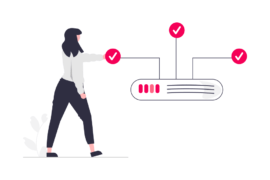There’s no denying that ensuring optimal email delivery stands as one of the most crucial factors behind a successful email marketing strategy. Yet, achieving an optimal email delivery rate requires a blend of experience and expertise.
Drawing from the wealth of expertise and insights gained over the years in the marketing domain, I am writing this blog to help marketers improve their email marketing efforts.
Without further ado, let’s dive right into the blog.
Top 8 Practices to Reach the Primary Inbox
Ensuring email delivery into the primary inbox requires a nuanced approach and mastering certain protocols and practices, which include:
1. Pass the Protocols
Email delivery relies on certain protocols for verification and each filter has its verification standard. These filters assess the sender’s reputation and content. Thus, to increase the chances of reaching someone’s inbox, you must successfully pass all these records. The filters include:
– SPF (Sender Policy Framework)
– DKIM (DomainKeys Identified Mail)
– DMARC (Domain-based Message Authentication, Reporting, and Conformance)
– BIMI (Brand Indicators for Message Identification) – Although not widely adopted yet since it’s new, using BIMI may become advantageous in the future.
2. Aim for 0.3% Domain Spam Rate
It is now advisable to aim for a domain spam rate of less than 0.3%, as Google has increased its strictness from the previous recommendation of 5%. There are a few tools to monitor the spam rate, one of them is Google Postmaster, which requires integration with the sender’s domain.
3. Check Email Copy Spam Score
Now speaking of the spam rate, it extends beyond just the domain spam score and includes your email copy. There are tools available to assess the overall spam score of your email content, with examples being Glockapps and Mailmeteor.
4. Separation of Domains for Email Resilience
Next, it’s suggested that your main domain and email domain to be distinct. The domain used for sending emails should be different from your main business domain. This precaution ensures that if the main domain ever gets blacklisted, it won’t impact your email deliverability. This separation allows your business operations to continue smoothly.
5. Localize Email Scheduling
We should send emails primarily based on the specific area and timing. For example – sending the same email at 9 AM in the US and India may not be effective. In India, people might be most active around 12 to 1 pm, while in the US, it might peak between 10 AM to 11 AM. Therefore, you should segregate the geography based on the specific time slots.
6. Email Warming
Warming up the domain is one of the best practices to reach the primary box. It’s a gradual process of establishing a positive reputation for a new email address. Email warming typically involves sending a small volume of emails initially, then gradually increasing the volume over time. This helps to build trust with email service providers, as sudden spikes in email activity from a new or inactive address may trigger spam filters.
‘Warmly’ is one of the tools that can help with domain warming. However, it’s important to note that a potential downside of using these tools is the likelihood of receiving a considerable amount of spam from their domain. It works on a give and take method, so anyone looking to use such tools should be prepared.
7. Personalization
Now coming to another practice – personalization. This includes addressing the recipients with their first names and greetings, which is a proven strategy to secure a spot in the primary email inbox. This makes the email more engaging and stand out from generic emails.
8. Avoid Spam Words
Lastly, avoid promotional words like ‘free’, ‘sales’, ‘best price’, order now etc in your subject line. Google and many email providers see them as a red flag. Thus, using such words to entice the receivers can end up impacting your email spam score.
Things to Avoid to Reach the Primary Box
To land into the primary inbox, we need to ensure that the email list is properly enriched. We can Utilize the email relevancy checking tool, ZeroBounce, to verify the accuracy and quality of the emails in the list.
Next, select an Ideal Customer Profile (ICP) aligned with your product or service to avoid sending irrelevant emails.
Next thing, which is not recommended, is relying on the auto-generated content. Doing so can result in the generation of generic and impersonal communication, which will lack the human touch and emotions.
Avoid excessive HTML and long texts. Encourage text-based emails. The more your email relies on plain text, the more effective it is likely to be. However, it does not mean not adding any designs or infographics at all. Avoid overly flashy designs to prevent your emails from being flagged by servers.
All these practices improve readability and boost engagement for more impactful communication.
Avoiding the Spam Trap: Learning from Mistakes
We use Mailmodo for sending out our campaigns, it requires AMP approval for new sender email addresses added to your domain. Last year, our sales team had to send out a campaign from a new email address but we did not have the approval at that time. It had to be sent without the approval and the larger chunk of it ended up landing in spam.
Examples of a Succesful Ad Email Campaign
In the B2B industry, an open rate of 18.5% and a CTR of 2.3% is considered the good industry average. Last quarter in October, we conducted a campaign which yielded great results- Open Rate of 29% and a CTR of 6%.
Helpful Hint
Create and send emails that speak directly to the user instead of using generic content. As mentioned earlier as well, doing so adds a personal touch and ensures that it’s not just another email trying to impose products and services on people.
In this era of personalization, it is important to align your content with the target group to enhance click-through rates (CTR). The more tailored and personalized your content, the higher the CTR is likely to be.
Final Words
In closing, we should always remember that behind every email address is a person. By applying the tips shared here, you’re not just improving metrics – you’re connecting with real individuals. So, keep it authentic, empathetic, and focused on building relationships. That’s the key to not just better delivery rates, but also lasting connections that go beyond the inbox.







